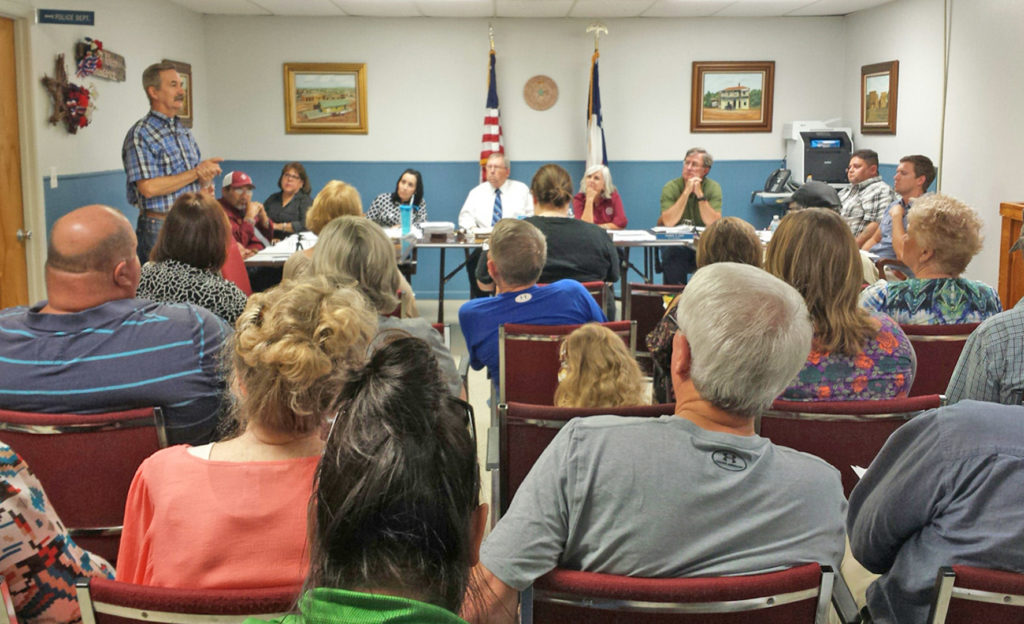
Dr. Richard Neel expressed confidence in the quality of the City of Devine’s drinking water at the Regular City Council meeting last Tuesday, June 20.
Neel, who has a medical degree from the University of Texas Health Science Center in San Antonio, a Masters degree in Public Health from Harvard, and studied occupational and environmental law at the Massachusetts Institute of Technology (MIT), is retired from the Air Force and currently practices family medicine and urgent care at the Little Alsace Clinic in Castroville. He attended the meeting to address citizens’ concerns over the spike in asbestos levels in the City’s water supply in the first three quarters of 2016.
The Environmental Protection Agency’s (EPA) Maximum Contaminant Level (MCL) for asbestos in drinking water is seven million fibers per liter (MFL).
The City’s water supply measured 14 MFL for ASB-01 in 1Q 2016; 17 for MFL ASB-01, 11 MFL for ASB-02, and 10 MFL for ASB-03 in 2Q 2016; and 18 MFL for ASB-01, 13 MFL for ASB-02, and 10 MFL for ASB-03 in 3Q 2016.
Asbestos, a naturally-occurring silicate mineral, is divided into two classes, serpentine and amphibole, according to Neel. Chrysotile, the only asbestos in the serpentine class, has curly fibers, while the amphibole class includes amosite, crocidolite, tremolite, anthophyllite, and actinolite, which have sharp, needle-like fibers.
“It’s important to note that all [of the City’s violations] is chrysotile,” Neel said, “which is actually the least harmful form of asbestos out there,” adding that the World Health Organization (WHO) doesn’t recommend monitoring asbestos levels in water because the group doesn’t consider it a danger.
When asked by Mayor Bill Herring how seriously the asbestos levels in the City’s water supply could affect citizens of Devine, Neel replied, “A short-term burst is usually not significant at all,” adding that chronic, long-term exposure is more of a danger.
Neel also mentioned studies that have been unable to definitively link exposure to asbestos in drinking water to cancer, including the Woodstock Asbestos Exposure Registry (WAER), undertaken by the New York State Department of Health after asbestos contamination was found in the water supply of Woodstock, NY.
According to the study’s final report, in November 1985, citizens in Woodstock reported a decrease in water pressure after an interruption of water service. Investigation by the NYS Department of Health discovered “strainers on faucets and showerheads were clogged with asbestos fibers,” likely due to the town’s corrosive water causing rapid deterioration of asbestos-cement pipes that had been installed in the mid- to late-1950s. Tests of a 1976 water sample were positive for asbestos, proving that the contamination had begun long before it was discovered.
WAER monitored rates of cancer for 2,936 participants who were exposed to Woodstock’s water between 1960 and 1985. Cancer rates from 1980 to 1998 were monitored, and the final report, issued in 2004, stated, “The general pattern of results did not demonstrate a likely link between exposure to asbestos in drinking water and cancer occurrence among participants in the WAER.” (The final WAER report, which also discusses results of other studies on asbestos in drinking water, is available online at https://www.health.ny.gov/environmental/indoors/ asbestos/woodstockreport.htm)
The first Devine resident to speak was Elia Merritt, who appeared unconvinced by the Neel’s testimony.
“Most Americans have one or below, that’s the asbestos count of America, one or below,” Merritt claimed.
Merritt’s claim mirrored a 1996 WHO background document (http://www.who.int/water_sanitation_health/ dwq/asbestos.pdf) for Guidelines for Drinking-water Quality, which stated, “The results of a number of surveys indicate that most of the population of the USA consumes drinking-water containing asbestos in concentrations below 1 MFL.”
A citation indicated that support for that statement came from “Asbestos in the water supplies of the United States” by James R. Millett, Patrick J. Clark, Judy Stober, and Montiel Rosenthal (http://images.biomedsearch.com /6662093/envhper00459-0050.pdf?AWSAccessKeyId=AKIAIBOKHYOLP4MBMRGQ&Expires=1498694400& Signature=Ijs2044YoVzkFQSVbOXkRLOgD%2BI%3D), which appeared in Vol. 53 of Environmental Health Perspectives in 1983, nearly 35 years ago.
“I expected you to say there was no problem,” Merritt continued, “but with what I’ve found, I’m not taking any chances.”
Neel reiterated that chronic, long-term exposure is what can be problematic, to which Merritt replied, “Well, I would say this is long-term.”
Herring immediately disagreed, arguing that one spike is not long-term.
Roxanne Westerholm expressed concern over inhaling water vapor with elevated asbestos levels.
“With the daily exposure to steam from our showers and from cooking, is that going to have an effect on our lungs?” Westerholm asked.
Neel confirmed that some asbestos remains when water that contains it is aerosolized, but said that most contaminants of that type “never make it down into the bottom of your lungs. Most of it is deposited in the nose and the upper airways and you cough it up.”
Jennifer Hammond said she had recently moved to Devine and thanked Westerholm for asking about breathing in steam in the shower.
“I know that the mist, breathing that in is really bad,” Hammond said.
“I’d actually rather breathe the asbestos than the chlorine in there,” Neel said, referring to the toxic chemical that is routinely added to drinking water to kill bacteria and microbes that could otherwise lead to outbreaks of waterborne diseases such as cholera, dysentery, and typhoid.
Hammond said she uses a charcoal filter on her shower, and is investigating the possibility of installing a filtration system for her entire house because she refuses to drink the “disgusting” Devine water.
Herring pointed out that since the spike in 2016, tests on samples taken by both TCEQ and the City have come back with results under seven MFL.
“Is our water good?” Herring asked.
“Yes, your water’s good,” Neel replied.
By Marly Davis
Staff Writer